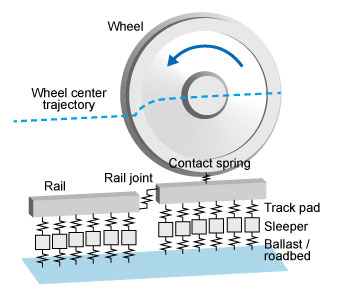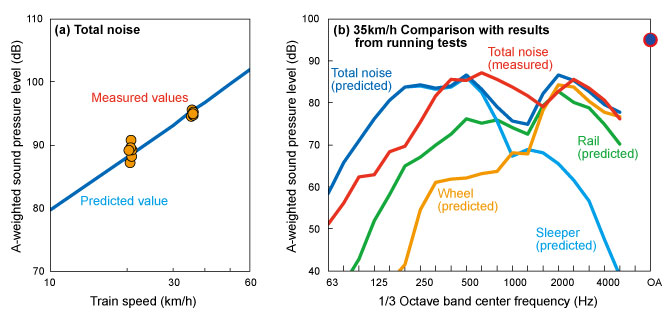3. Model for predicting impact noise of vehicles running over rail joints
- A model for predicting the impact noise of vehicles running over rail joints was proposed; the suitability of the developed model was then verified.
- The prediction model was subsequently applied to gain insight into the contribution of each sound source to total impact noise.
An impact force is produced between the rail and the wheel of a railway vehicle as it goes over a rail joint. This generates impact noise. In order to gain insight into the mechanisms generating impact noise between the rail joint and the wheel, tests were performed on the test track at RTRI. Tests included impact excitation of the rail and the wheel and measurement of noise and vibrations produced by a running vehicle.
Impact excitation test results showed that it was possible to evaluate rail joint vibration characteristics in a model comprising a spring element as the joint fishplate and two semi-infinite beam elements representing the rail. The excitation force between the rail and the wheel was evaluated through an analysis model in the time domain which considered the trajectory of the wheel centre and non-linearity of the contact spring when passing over the rail joint (Fig.1).
A model for predicting impact noise was constructed by combining these elements with the traditional rolling noise forecast method (TWINS Model). Track side noise was measured during test track runs, and these measured values correlated well with those predicted through the model, validating its suitability. The above insight also clarified the contribution of each source, i.e. wheel, rail, sleepers, etc. to total impact noise (Fig.2). Further research is planned to investigate how to increase the accuracy of noise prediction using actual data collected from commercial lines, with a view to making proposals and evaluating measures for abating impact noise.

Fig.1 Impact noise prediction model
Fig.2 Results of impact noise prediction method ( joint step-down height: 1.3 mm joint gap; play: 5.5 mm)